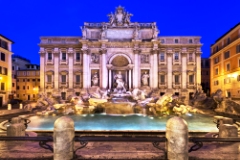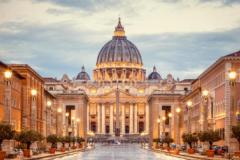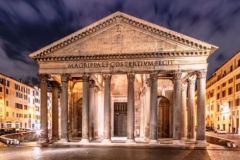-
>EN
- Booking Now

- 1.
- Tour
Repubblica Square, Nazionale street, Quirinale and Trevi Fountain
Book your tour here!
Our visit to Rome near us start from Piazza della Repubblica. Its ancient name is Piazza Esedra, because of its semicircular shape, it was built in the late nineteenth century. with beautiful arcades. At the center of the square is the Fontana delle Naiadi by A. Guerrieri. It caused a scandal when in 1901 it was embellished by Mario Rutelli with four naked nymphs each of which lying on an aquatic animal. In the center there is the marine god Glauco figure added later by Rutelli himself.
Piazza della Repubblica presents the evocative scenery of the Baths of Diocletian built by the Emperor between 298 and 300 BC, they were the largest spa of the time, they could accommodate more than 3000 people. Today occupied by the church of Santa Maria degli Angeli and the National Roman Museum, the few rooms of the thermal baths left, make us imagine the splendor and grandeur of this building. The Church of Santa Maria degli Angeli, incorporated into the remains of the thermal baths, was designed by Michelangelo in the Tepidarium area.
In the area of the Baths of Diocletian, there is the National Roman Museum. It is one of the most important archeological museums in the world, it preserves a large part of the ancient works found in Rome, making up the collection of sarcophagi, mosaics and statues. Minor works from the museum are visible in the cloister designed by Michelangelo.
Via Nazionale starts from Piazza della Repubblica. It is a street that attracts many tourists and Romans because it is full of commercial activities and shops. The Palazzo delle Esposizioni and the Teatro Eliseo are also located here.
Almost at the end of via Nazionale on the right we find via XXIV maggio, going along we arrive in piazza del Quirinale. It takes its name from the highest hill in Rome flanked by sumptuous palaces, the popes made it their summer residence and thus the kings of Italy. In the square there are the Dioscuri fountain, the Palazzo della Consulta and the Palazzo del Quirinale.
The Quirinal Palace was started by Martino Longhi the Elder, at the behest of Gregorio XIII. The pope chose this splendid hill as a summer residence. Numerous architects worked there such as the Fontana, he was responsible for the main facade, Carlo Maderno designed the Paolina chapel, and Bernini for the narrow wing called long sleeve that overlooks via del Quirinale. The ancient papal palace currently houses the President of the Republic.
From via della Dataria, continue along via di San Vincenzo where you can see the Church of Saints Vincenzo and Anastasia. This church has one of the most beautiful baroque facades in Rome, the columns are crowned by the insignia of Cardinal Mazzarino who commissioned the construction of the church from Martino Longhi the Younger. It was erected in 1650. The grandiose facade of this church overlooks one of the most prestigious fountains in Rome: the Trevi Fountain.
Erected on one side of the Poli building, initially of modest proportions, it assumed a grandiose form in 1732 thanks to the project by Nicola Salvi. Divided into three niches from which water flows, in the central there is the ocean drawn by two horses supported by two tritons, in the side niches we observe the statues of Abundance and Health. Here a play of water is created that forms waterfalls which lap the sculptures among them, the Lovers' Fountain. According to an ancient tradition, anyone who throws a coin into the fountain will return to the eternal city.
Book your tour here!



